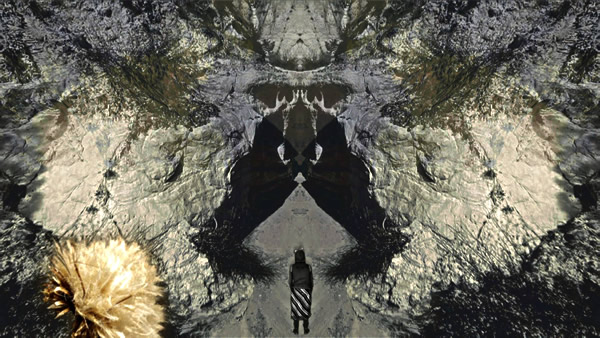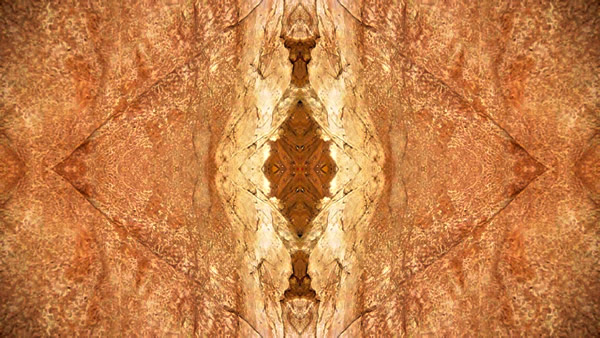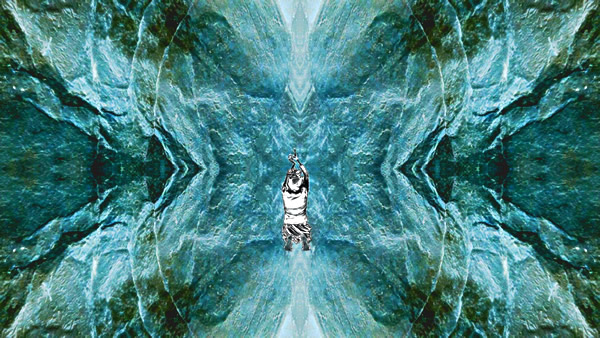
INterzone’s title text ascends in an expressive flair, setting an introductory tone for Flame Schon’s singular action expressed as a psychedelic video that expands straight documentation into a stylized, creatively independent artwork. Schon walks through a narrow cavernous passageway found in a mountainous New Mexican landscape guided by her video camera, shooting a realtime first-person perspective of her experience. A kaleidoscopic effect was applied in post-production, transforming process into product and thereby generating a subjective spectacle for the viewer to contemplate. As she reaches the end of the passage, she returns through the tunnel once again with the image’s color inverted, giving the viewer a blue negative of the once warm, reddish earthtones initially presented. A masked human figure occasionally appears, miniaturized and enveloped by the cascading walls. The figure happens to be Schon’s recurring Daughter of Dada character, a spiritual heroine born of the anarchic Dadaist movement. The figure faces forward, assuming poses that mirror the shifting visual formations, either walking or kneeling with raised arms and at times fragmented, embodying the divine symbology of hands historically and cross-culturally referential. As a whole, INterzone alludes to transcendental states through metaphor and design with aesthetics evocative of Native American and Islamic geometry. At the point of transition as Schon pivots to retrace her steps, the human figure walks across the screen in garb emblematic of a shaman.

The title INterzone recalls the William Burroughs’ Tangier-influenced literary space of metaphorical and actual intersection that provided new cerebral possibilities. “A portal to the crack between worlds,” her statement reads. Conceiving and exploring transcendence, altered states, and autonomous zones via psychedelia is the underlying theme of Schon’s oeuvre. Having a collaborative history with subversive icons like Ira Cohen, Vali Myers, and ex-husband Sheldon Rochlin, Schon has had her place in building psych culture from the roots up. After a career of docu-fictitious hybrids that showcased underground societies and the Daughter of Dada mythic journey series that followed, Schon has now removed social contexts and narratives so that she may enact the Self as transmitter and experiencer. The action is simple; walking, to exist and interact with your environment in a fundamental fashion. In 1967, the sculptor Richard Long’s A Line Made by Walking blurred the line between object and performance by photographing the trail left from walking back and forth. This seminal work helped initiate a discourse on “body + landscape” in contemporary art along with the psychogeographical maps of the Situationist derive and conceptual performances ranging from Vito Acconci to Bruce Nauman. In the advent of New Media, Schon introduces technology to the conversation by utilizing a video camera as a mode between fields, expanding the conversation to “body + technology + landscape.” Similarly so, Robert Smithson and Nancy Holt questioned perception with technology (in this case a 16mm camera) as intermediary with Swamp (1969), where Holt navigated her environment solely through a viewfinder aided with verbal direction by Smithson. Unlike Swamp, INterzone is concerned with pushing the boundaries of perception and consciousness more subjectively through the technology rather than operating under its dictations. The jagged, gaping orifice of INterzone’s passageway endlessly expands and collapses amidst forward momentum, providing entrancing imagery via a non-structured repetitive motion.

A more fitting allegiance would be found in the structuralist film works of Paul Sharits, whose psychodramatic simulations of seizures encouraged ecstatic states, transgressing passive viewing. A conceptual parallel also lies with the Art/Life performer Linda Montano’s foray into video with pieces like Mitchell’s Death (1977) and Primal Scenes (1980), which shares catharsis as a form-meets-function byproduct. In the vein of psychedelia, beyond Schon’s ties to her contemporaries like Cohen, the work of filmmaker and videographer Toshio Matsumoto employed polychromatic hypnosis through visual deconstructions of landscape, body, and architecture by pushing the limits of his tools. Placing INterzone in these historical contexts reinforces a critical interpretation that accounts for how the current state of art, technology, and culture intersects with a visionary pursuit. Schon’s unconventional use of the video camera in a poetic and philosophical investigation aligns her with the prospect of New Media as an art movement that repurposes the practical intent of technology. As emerging technologies grow increasingly integrated with meatspace, New Media reflects the cultural climate in relation to these new tools and systems. Fixations on connecting the organic world with the digital one that rely on replications of chaotic systems generated by algorithms and aesthetic representations of natural environments highlight theoretical concerns of identity; where humanity lies within a burgeoning non-human empire. In-line with psychedelic methods and their place in contemporary art history, Schon surpasses this concept of unifying the organic and digital on a materialistic level, allowing her to exhibit ineffable states of existence through the medium.
Flame Schon’s INterzone was exhibited at 2015’s Currents International New Media Festival in Santa Fe, New Mexico.
View Flame Schon’s INterzone here.
–review by JC Gonzo
Reviews Video
What is forgery crimes and why it is fraud ?. Forgery crimes is fake signature and without
permission making a false documents or every where.
What is duplicate invoices and waht is processed of duplicate invoices and what
is detict of thid crimres.